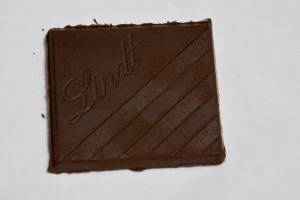Hello, my name is Julia, and I am a chocoholic.
 I’d like to say I’ve never met a chocolate bar I didn’t like, but that’s not entirely true. I don’t like chocolate bars with almonds in them. I’m not a huge fan of almonds. They get in the way.
I’d like to say I’ve never met a chocolate bar I didn’t like, but that’s not entirely true. I don’t like chocolate bars with almonds in them. I’m not a huge fan of almonds. They get in the way.
But this particular chocolate bar was almond-free. In fact, it was just your average chocolate bar, with one deviation: someone, somewhere along the way, decided it would be a good idea to add salt to it.
Salt and chocolate…interesting, but not impossible, I suppose. I mean, chocolate-covered pretzels are great. So is Chocolate Turtle Chex Mix. So sure, I’d never heard of a chocolate bar with some extra salt added, but it couldn’t be that bad.
What stood out to me was that the self-proclaimed special ingredient was no ordinary salt: it was sea salt. I suppose this makes it a gourmet food. I wouldn’t really know, because the only known contact I’d had with sea salt up until this point was when I used sea salt bath scrub, and also when I swam in the Pacific Ocean.
I’ve heard sea salt marketed as a healthy, organic alternative to “normal” table salt. (Evaporation equals superiority, apparently.) According to Mayo Clinic, however, the nutritional values are the same. The only significant difference between the two is flavor.
So with that in mind, it was time to see what effect a little bit of salt extracted from evaporated ocean water would have on a bar of chocolate.
Slowly, almost reverently (since the packaging was pretty), I tore my way through the cardboard till I reached the chocolatey goodness inside. It looked like any ordinary chocolate bar. I don’t know if I was expecting to see salt-encrusted chocolate, little sea urchins clinging to the brown squares, or what, but I was somehow surprised at how normal it looked. How much different could a little sea salt make?
I took a bite (or, more accurately, put an entire square in my mouth). Since I missed the part of the package that read “DARK” in capital letters, I expected it to be sweet. It wasn’t. Instead, it tasted bitter — like dark chocolate should be, though a little stronger than normal. I didn’t taste salt, though. Toward the end, when I finally swallowed the chunk of chocolate, there was a slight salty aftertaste. Very slight. I stood looking at the rest of the bar for a second, a little disappointed.

And then, out of nowhere, cottonmouth attacked.
(By cottonmouth I mean the condition of having a dry mouth…not the snake. I did not have an Indiana Jones moment, just so we’re clear.)
I whirled around and flung open the refrigerator door, only to have my hopes shattered. “There’s no milk!” I croaked out. (All right, so I’m exaggerating about the croaking.) I ran — yes, ran — out to the garage fridge, grabbed a gallon without slowing down, and flew back into the kitchen to pour myself a tall glass. I chugged it.
Lesson #1 in grade school chemistry: salt makes you thirsty.
Once I’d downed a second glass of milk, I picked up the chocolate package, wondering what exactly drove Lindt to add “a touch of sea salt” to some dark chocolate.
The taste reveals a harmony of unexpected contrasts: the intensity of dark chocolate and the delicate seasoning of hand harvested Fleur de Sel sea salt crystals.
I got the chocolate intensity part from the bitterness. What I didn’t get was the salty “seasoning.” Maybe it was too delicate to be noticeable.
But it wasn’t too delicate to make me incredibly thirsty afterward.
I have to say, I was a little disappointed at the results of this little experiment. I had expected a more interesting, complicated taste from a combination like salt and chocolate. What I got instead was ordinary chocolate with a side of thirst. Maybe the bitterness overrode the saltiness, or maybe my taste buds are failing me in my old age. Whatever the case, when I (in a chocoholic stupor, of course) finish the rest of the bar in one sitting, I’ll be sure to keep a glass (or two) of cold milk handy.
———-
Ingredients: Sugar, chocolate, cocoa butter, butterfat (milk), soya lecithin (emulsifier), sea salt and vanilla.
Price:$3.49 at Safeway
Pros: Chocolate.
Cons: Intense thirst.








